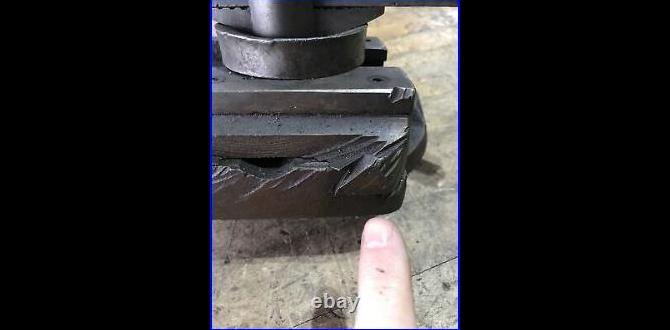Carbide end mills deliver exceptional, long-lasting performance when machining aluminum, especially when choosing the right type and using proper techniques. This guide will show you how to maximize their lifespan for smooth, efficient aluminum cutting.
Hey there, fellow makers! Daniel Bates from Lathe Hub here. Ever get a little frustrated when your cutting tools just don’t seem to last as long as you’d hoped, especially when working with aluminum? It’s a common hurdle, but thankfully, there’s a really effective solution: carbide end mills. These beasts are designed for tough jobs, and when you pick the right one for aluminum, they can keep going and going. Let’s dive into how you can get the most out of your carbide end mills, ensuring they stay sharp and precise for all your aluminum projects. We’ll cover everything from selecting the perfect tool to the best ways to use it.
Understanding Carbide End Mills for Aluminum
Carbide end mills are the workhorses of modern machining. Made from tungsten carbide, a super-hard material, they can handle much higher cutting speeds and tougher materials than traditional high-speed steel (HSS) tools. For aluminum, this hardness translates directly into a longer tool life because aluminum, while soft, can be gummy and abrasive in its own way, which can quickly dull other types of cutters. The key is understanding what makes a carbide end mill “aluminum-friendly.”
Why Carbide is King for Aluminum
- Hardness: Tungsten carbide is incredibly hard, resisting wear and abrasion much better than HSS. This means it stays sharp longer, even when cutting through aluminum.
- Heat Resistance: Machining generates heat. Carbide can withstand much higher temperatures than HSS without losing its temper or hardness. This is crucial, as aluminum can stick to the cutting edge, increasing friction and heat.
- Rigidity: Carbide is a stiffer material, leading to less tool deflection. This means more accurate cuts and a better surface finish on your aluminum parts.
- Higher Cutting Speeds: Because they are harder and more heat-resistant, you can run carbide end mills at significantly faster speeds and feeds. This dramatically speeds up your machining time.
Special Features for Aluminum End Mills
Not all carbide end mills are created equal, especially when it comes to aluminum. You’ll want to look for specific features:
- Number of Flutes: For aluminum, it’s generally recommended to use end mills with fewer flutes.
- 2 or 3 Flutes: These are ideal for aluminum. The larger chip gullets (the space between the flutes) allow for better chip evacuation. Aluminum tends to produce long, stringy chips that can pack up and cause issues. More flutes mean smaller chip gullets, increasing the risk of clogging and “re-cutting” chips, which leads to tool wear and poor finishes.
- Polished Flutes: Many end mills designed for aluminum have highly polished flutes. This non-stick surface reduces the tendency for aluminum to adhere to the cutting edge (a phenomenon called “built-up edge” or BUE). A polished surface helps chips slide away cleanly, keeping the cutter sharp and the finish smooth.
- Specific Geometry: Some end mills have optimized flute geometry, helix angles, and sharp cutting edges specifically designed to shear aluminum cleanly without excessive force or friction.
- Coating: While many aluminum-specific end mills are uncoated to take advantage of the carbide’s natural lubricity and polished surface, some might benefit from specialized coatings like TiB2 (Titanium Diboride) or DLC (Diamond-Like Carbon) for extreme wear resistance and non-stick properties, though these are often overkill for hobbyist use. For most beginners, a sharp, polished, uncoated carbide end mill is perfect.
When you see an end mill described as “for aluminum,” it usually means it has these characteristics: 2-3 flutes and polished cutting surfaces.
Selecting the Right Carbide End Mill for Your Aluminum Project
Choosing the correct end mill is the most critical step. Let’s break down the key factors:
Diameter and Reach
The diameter of the end mill you need depends entirely on the size of the features you want to create. For general milling, pocketing, and profiling, pick a diameter suitable for the job. For features like deep pockets or slots, you might need a “long reach” or “extended reach” end mill. These have a significantly longer shank to clear the workpiece and allow access to deeper areas without the spindle housing or tool holder crashing into the part.
A common size for general aluminum work is the 1/8 inch (3.175mm) or 1/4 inch (6.35mm) diameter end mill. For aluminum 7075, which is a high-strength alloy, a rigid setup and a sharp tool are even more important. A 10mm shank is common for many larger end mills, offering more rigidity than smaller shanks for heavy cuts.
Helix Angle
The helix angle refers to the spiral of the cutting edges. For aluminum, a higher helix angle (around 30-45 degrees) is generally preferred. This steep angle helps the tool “pull” the material away from the cut and provides a shearing action that is very effective on softer, gummier materials like aluminum. It also helps with chip evacuation.
Types of Carbide End Mills for Aluminum
When shopping, you’ll primarily encounter these types, all made from carbide:
- Square End Mills: These have flat ends and are used for general milling, slotting, and creating square corners. They are the most common type.
- Ball End Mills: These have a rounded tip and are used for creating contoured surfaces, fillets, and 3D machining.
- Corner Radius End Mills: These are similar to square end mills but have a small rounded corner to provide a radius, adding strength and reducing stress risers in the machined feature.
For most beginner aluminum milling, a 2-flute, polished, uncoated square end mill is the go-to choice. If you need to create fillets, a ball end mill with similar characteristics is best.
Essential Machining Parameters for Aluminum
Getting the “long life” part of your carbide end mill comes down to using it correctly. This means setting the right cutting speeds and feed rates. These numbers are not arbitrary; they are calculated to balance efficiency, tool life, and surface finish. For aluminum, you can generally afford to be more aggressive than with steel.
Cutting Speed (Surface Speed – SFM)
Cutting speed, often expressed in Surface Feet per Minute (SFM), is the speed at which the cutting edge moves across the material. For carbide end mills cutting aluminum, a common range is between 300 SFM and 1000 SFM. Higher speeds are possible with good chip evacuation and coolant.
Feed Rate (IP T – Inches Per Tooth)
Feed rate is how fast the tool advances into or through the material. It’s often expressed as Inches Per Tooth (IPT) or millimeters per tooth (mm/tooth). This means the amount of material removed by each cutting edge per revolution. For aluminum with a 2-flute end mill, a good starting point for IPT might be 0.001 to 0.004 inches per tooth, depending on the diameter of the end mill.
Chipload Calculation: Basic Formula
You can calculate the feed rate per minute (FPR) using the chip load (IPT):
FPR (in/min) = Chipload (IPT) × Number of Flutes × Spindle Speed (RPM)
To use this, you first need to know your desired spindle speed (RPM). You can determine RPM based on your target SFM:
RPM = (SFM × 3.82) / Diameter (inches)
Or for metric:
RPM = (SCM (m/min) × 1000) / (π × Diameter (mm))
Let’s look at an example. Suppose you’re using a 1/4 inch diameter, 2-flute carbide end mill on aluminum, aiming for 500 SFM and a chipload of 0.002 IPT:
- Calculate RPM:
RPM = (500 SFM × 3.82) / 0.25 inches = 7640 RPM - Calculate Feed Rate:
FPR = 0.002 IPT × 2 flutes × 7640 RPM = 305.6 inches per minute
These are starting points. You’ll always want to adjust based on how the cut sounds, looks, and feels. If chips are packing, reduce the feed rate or increase spindle speed slightly. If the tool is chattering, you might need to reduce speed or feed, or potentially use a different tool geometry.
Depth of Cut and Width of Cut
Related to chipload, the depth and width of your cut significantly impact tool life and cutting forces.
- Width of Cut (Axial Engagement): For aluminum, engaging a large portion of the end mill’s diameter (e.g., 50-100% for full slotting) can be problematic with standard milling strategies. High-Efficiency Machining (HEM) or trochoidal milling strategies use a much smaller width of cut (e.g., 10-20% of the tool diameter). This keeps the chip load consistent, reduces heat buildup, and allows higher feed rates while putting less stress on the tool. For beginners, a smaller width of cut is often more forgiving.
- Depth of Cut (Radial Engagement): When roughing, you can often take a decent depth of cut. For a 1/4 inch end mill, a depth of cut of 0.100 to 0.250 inches might be reasonable, depending on your machine’s rigidity and the material. For finishing passes, you’ll want a much shallower depth of cut (e.g., 0.010 – 0.050 inches).
It’s generally better to take multiple light passes rather than one heavy pass. This is especially true when using a long reach end mill, which is less rigid than a standard length tool.
For the aluminum alloy 7075, which is a strong and common aerospace-grade aluminum, these principles are even more important. Its hardness means you need sharp tools and proper parameters to avoid rapid wear.
Setting Up Your Machine for Success
Even the best end mill will suffer if your machine isn’t set up correctly. Rigidity, coolant, and tool holding are paramount.
Rigidity is Key
A machining setup needs to be rigid. This means:
- Machine Slop: Ensure there’s no excessive play in your machine’s ways, ball screws, or spindle bearings.
- Workholding: Clamp your aluminum workpiece securely. Use the largest surface area possible for clamping. Avoid trampolines!
- Tool Holder: Use a high-quality tool holder, like a hydraulic or shrink-fit holder if available, for the best runout and grip. A basic ER collet chuck is also common and effective. Avoid just sticking the end mill shank directly into a drill chuck unless absolutely necessary for very light cuts. Runout reduces effective cutting diameter and increases wear.
Coolant or Lubrication
While some machining operations on aluminum can be done dry, using a coolant or lubricant significantly improves tool life and surface finish. It:
- Cools the cutting edge, preventing heat buildup and extending tool life.
- Lubricates the cut, reducing friction and preventing chips from welding to the tool.
- Helps flush chips away from the cutting zone.
For aluminum, a flood coolant system is ideal. If that’s not possible, mist coolant or even a simple spray of cutting fluid or WD-40 can make a noticeable difference. Avoid using oils that become too sticky at higher temperatures. A common choice is a water-soluble coolant with good lubricity.
Always follow safe practices when using coolants. Consult safety guidelines from your coolant manufacturer and ensure proper ventilation and personal protective equipment.
Tool Length and Stick-Out
The more your end mill “sticks out” from the tool holder, the less rigid it is. Try to keep the stick-out (the length of the end mill shank extending beyond the collet or holder) to a minimum necessary to complete the cut. For cutting any significant depth, a long reach end mill will naturally have more stick-out, requiring you to use lighter depths of cut and feed rates.
Choosing the Right Carbide End Mill for Aluminum 7075 and Long Reach Tools
When diving into materials like Aluminum 7075, which is known for its strength and can be a bit more challenging than softer alloys, the principles we’ve discussed become even more critical. Similarly, when you need a long reach end mill, you’re introducing a structural compromise that demands careful consideration.
Aluminum 7075 Specifics
Aluminum 7075 is a precipitation-hardening aluminum alloy with excellent strength-to-weight ratio. It machines well, but its hardness means:
- Sharpness is Paramount: A dull tool will quickly create excessive heat and wear.
- Chip Evacuation is Crucial: Stringy chips can still be an issue, and if they pack, they’ll rapidly abrade the cutting edge.
- Coolant is Highly Recommended: It helps manage the heat generated, which is more significant with harder materials.
For 7075, stick to the 2 or 3-flute, high-helix, polished geometry end mills. You might need to slightly reduce your cutting speeds and feeds compared to softer aluminums, but the principles remain the same. Always start conservatively and increase as your confidence and experience grow.
Long Reach End Mills (e.g., 1/8 inch 10mm Shank Long Reach)
A “long reach” end mill is simply an end mill with an extended shank. This is necessary for parts that require pockets or features that are deeper than what a standard length end mill allows you to reach without the tool holder colliding with the workpiece. For example, a 1/8 inch diameter end mill with a 10mm shank might have a total length of 4 or 6 inches, with 2-3 inches of that being the fluted cutting section and the rest being unsupported shank. This is a lot of “stick-out.”
The challenges with long reach end mills:
- Reduced Rigidity: The longer the unsupported shank, the more it will deflect under cutting forces. This can lead to inaccurate cuts, chatter, and increased tool wear.
- Vibration: Increased stick-out is more prone to vibration, which is detrimental to tool life and surface finish.
- Spindle Load: More stress on the spindle and tool holder.
So, for long reach end mills, especially in aluminum 7075:
- Reduce Depth of Cut (Radial and Axial): Take shallower passes.
- Reduce Feed Rate: Lower the feed rate to reduce cutting forces.
- Consider Down-Milling: If your CNC machine supports it, down-milling (climb milling) can sometimes provide a smoother cut with less vibration than conventional milling for aluminum. However, be aware that conventional milling can sometimes provide better chip control. Experimentation is key.
- Use High-Feed Milling (HEM) Strategies: If using CAM software, trochoidal milling (a type of HEM) is your friend. It keeps the radial engagement very low (often 20% of the tool diameter or less





